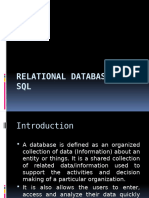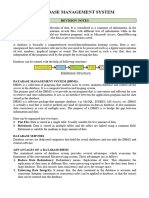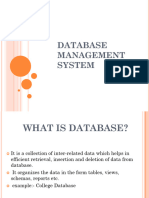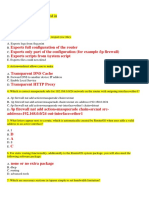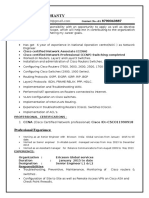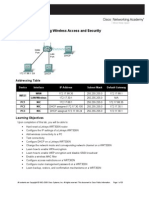What Is A Database
Uploaded by
James Brian FloresWhat Is A Database
Uploaded by
James Brian FloresWhat Is a Database?
Database is a collection of structured information. Databases are designed specifically to manage large
bodies of information, and they store data in an organized and structured manner that makes it easy for
users to manage and retrieve that data when required.
A database management system (DBMS) is a software program that enables users to create and
maintain databases. A DBMS also allows users to write queries for an individual database to perform
required actions like retrieving data, modifying data, deleting data, and so forth.
DBMSs support tables (a.k.a. relations or entities) to store data in rows (a.k.a. records or tuples) and
columns (a.k.a. fields or attributes), similar to how data appears in a spreadsheet application.
A relational database management system, or RDBMS, is a type of DBMS that stores information in
the form of related tables. RDBMS is based on the relational model.
Choosing Between a Spreadsheet and a Database
1. Retrieve all records that match particular criteria.
2. Update or modify a complete set of records at one time.
3. Extract values from records distributed among multiple tables.
Why Use a Database?
Following are some of the reasons we use databases:
Compactness: Databases help in maintaining large amounts of data, and thus completely
replace voluminous paper files.
Speed: Searches for a particular piece of data or information in a database are much
faster than sorting through piles of paper.
Less drudgery: Maintaining files by hand is dull work; using a database completely
eliminates such maintenance.
Currency: Database systems can easily be updated and so provide accurate information
all the time and on demand.
Benefits of Using a Relational Database Management System
Advantages:
1. Redundancy - prevent having multiple duplicate copies of the same data, which takes up disk
space unnecessarily.
2. Inconsistency
3. Data integrity
4. Data atomicity
5. Access anomalies
6. Data security
7. Transaction processing: A transaction is a sequence of database operations that represents a
logical unit of work. In RDBMSs, a transaction either commits all the changes or rolls back all the
actions performed until the point at which failure occurred.
8. Recovery: Recovery features ensure that data is reorganized into a consistent state after a
transaction fails.
9. Storage Management.
Comparing Desktop and Server RDBMS Systems
Desktop Databases - Desktop databases are designed to serve a limited number of users and run on
desktop PCs, and they offer a less-expensive solution wherever a database is required.
Advantage: Less expensive, User friendly
Server Databases - specifically designed to serve multiple users at a time and offer features that allow
you to manage large amounts of data very efficiently by serving multiple user requests simultaneously.
What is SQL?
SQL stands for Structured Query Language
SQL lets you access and manipulate databases
SQL is an ANSI (American National Standards Institute) standard
SQL is a Standard - BUT....
Although SQL is an ANSI (American National Standards Institute) standard, there are many
different versions of the SQL language.
However, to be compliant with the ANSI standard, they all support at least the major commands
(such as SELECT, UPDATE, DELETE, INSERT, WHERE) in a similar manner.
SQL DML and DDL
SQL can be divided into two parts: The Data Manipulation Language (DML) and the Data
Definition Language (DDL).
The query and update commands form the DML part of SQL:
SELECT - extracts data from a database
UPDATE - updates data in a database
DELETE - deletes data from a database
INSERT INTO - inserts new data into a database
The DDL part of SQL permits database tables to be created or deleted. It also defines indexes
(keys), specifies links between tables, and imposes constraints between tables. The most
important DDL statements in SQL are:
CREATE DATABASE - creates a new database
ALTER DATABASE - modifies a database
CREATE TABLE - creates a new table
ALTER TABLE - modifies a table
DROP TABLE - deletes a table
CREATE INDEX - creates an index (search key)
DROP INDEX - deletes an index
You might also like
- Jetking Certified Hardware and Networking ProfessionalNo ratings yetJetking Certified Hardware and Networking Professional13 pages
- Unit - 3 Realtional Database Management SystemNo ratings yetUnit - 3 Realtional Database Management System35 pages
- 03 Database Management System Revision NotesNo ratings yet03 Database Management System Revision Notes10 pages
- Information Management: Introduction, Database ConceptsNo ratings yetInformation Management: Introduction, Database Concepts31 pages
- The Database Approach To Data ManagementNo ratings yetThe Database Approach To Data Management35 pages
- Database Administration and Management Lecture 2No ratings yetDatabase Administration and Management Lecture 221 pages
- 03 Database Management System Revision NotesNo ratings yet03 Database Management System Revision Notes12 pages
- Urmimala Ma'Am Done by MD Samir Khan: BBA 4BNo ratings yetUrmimala Ma'Am Done by MD Samir Khan: BBA 4B18 pages
- SQL Interview Questions - in Word FormatNo ratings yetSQL Interview Questions - in Word Format15 pages
- 03 Database Management System Revision NotesNo ratings yet03 Database Management System Revision Notes10 pages
- DATABASE MANAGEMENT SYSTEM Class Xi Unit 2 ExamNo ratings yetDATABASE MANAGEMENT SYSTEM Class Xi Unit 2 Exam4 pages
- Vaibahav Rai Class-10th Database Management SystemNo ratings yetVaibahav Rai Class-10th Database Management System18 pages
- Lecture 3 - BCSE302L - DBMS ArchitectureNo ratings yetLecture 3 - BCSE302L - DBMS Architecture17 pages
- Action Redirect Is Applied In: Sample QuestionsNo ratings yetAction Redirect Is Applied In: Sample Questions5 pages
- Information Systems in Global Business Today100% (1)Information Systems in Global Business Today3 pages
- Pandigital Digital Photo Frame 8" PI8004W01BNo ratings yetPandigital Digital Photo Frame 8" PI8004W01B54 pages
- TAS Network Gateway 3.0: The Solution To Access Interbank Networks and Manage Financial Data ExchangesNo ratings yetTAS Network Gateway 3.0: The Solution To Access Interbank Networks and Manage Financial Data Exchanges4 pages
- Assembly Language Lecture From Engr GatdulaNo ratings yetAssembly Language Lecture From Engr Gatdula16 pages
- Specification Monitor Ad Notam DFU-0550-4K PreliminaryNo ratings yetSpecification Monitor Ad Notam DFU-0550-4K Preliminary3 pages
- CCNA 4 Chapter 4 v5.0 Exam Answers 2015 100No ratings yetCCNA 4 Chapter 4 v5.0 Exam Answers 2015 1008 pages
- SMK Yadika 4 Lab Sheet Infrastruktur Jaringan: 1. Instalasilah Paket Program Cisco Packet TracerNo ratings yetSMK Yadika 4 Lab Sheet Infrastruktur Jaringan: 1. Instalasilah Paket Program Cisco Packet Tracer4 pages
- ANA371RefGuide (Cisco Pseudo Wire, Carrier Ethernet)No ratings yetANA371RefGuide (Cisco Pseudo Wire, Carrier Ethernet)1,306 pages
- Eurosec Course Material On Web Application Session ManagementNo ratings yetEurosec Course Material On Web Application Session Management25 pages
- Recovery Instructions For The Android 2.1 Flytouch 2 SuperPadNo ratings yetRecovery Instructions For The Android 2.1 Flytouch 2 SuperPad2 pages
- Quectel GSM TCPIP Recommended Process V2.0No ratings yetQuectel GSM TCPIP Recommended Process V2.021 pages












